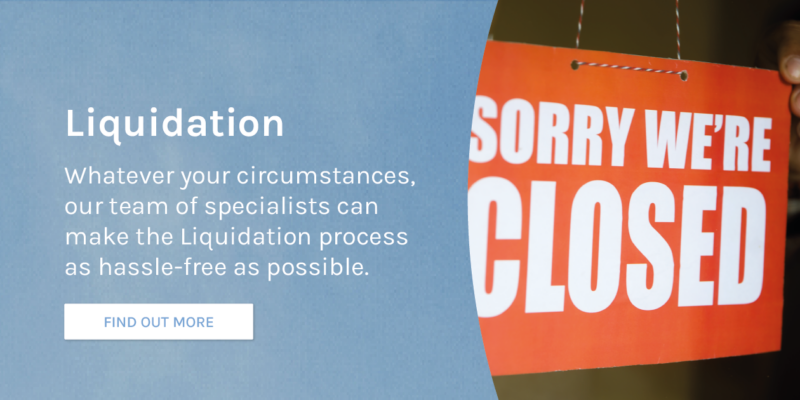Running a business could be compared to flying a plane. While take-off is famously tricky — 20% of startups fold after the first year alone — it represents the first of many complex manoeuvres needed to stay in the air. The fact is that, even after you’ve left the security of the runway behind, you’ll still require a sense of direction and reliable fuel supplies to remain airborne. However, for some businesses, ‘fuel’ can quickly become a scarce commodity, making coming in for a final landing the only option. Once this decision has been made, choosing the method of descent is all that remains.
If your company has passed the financial point of no return, there are effectively three liquidation options at your disposal. Although one of these is imposed upon you by creditors, the others offer priceless opportunities to manage your own landing. However, each strategy has its own unique characteristics, meaning some could be more appropriate to your goals than others.
In this blog, we’ll cut through the turbulent air of insolvency by delving into the main types of liquidation. You’ll find everything you could possibly need to push through the storm clouds and hit bluer skies.
Liquidation Option 1: Creditors’ Voluntary Redundancy
Once you’ve tried unsuccessfully to return to solvency, a Creditors’ Voluntary Redundancy (CVL) is your final roll of the dice. If you’ve accepted that you can’t settle debts, a CVL can help you to fulfil your legal obligations as a director by putting the financial interests of creditors first — ensuring that at least some of them can recoup funds owed.
Of the available liquidation options, this one stops you from operating while insolvent, which can help you avoid potentially damaging allegations of wrongful trading. Rather than making the situation worse by finding new lines of credit or borrowing more money, this approach shows that you’ve recognised the severity of the situation and are committed to closing down your business in a more structured and legally-compliant way. And, because you are the one instigating liquidation, you will also have more control over the process.
Why Choose this Type of Liquidation?
In aeronautical terms, instigating a CVL is akin to keenly noticing dwindling fuel and preparing to make an emergency landing — indicating that your main concern is the wellbeing of passengers. Not only do you get to choose a liquidator and write off debts, but doing the right thing should make it easier to begin a new business venture in the future.
The key advantages of a CVL are:
- Qualify For Redundancy Pay: Have you been paid through PAYE by your business for 16+ hours weekly over a two year period? If the answer is ‘yes’, you will qualify for redundancy pay.
- More Control: Once you’ve set the wheels in motion for a CVL, you get to control the process through to the end. This means that you can choose your own liquidator and the company won’t be forced to wind up by creditors.
- Release the Pressure: Once the undertaking begins, the realising of debts becomes the responsibility of the liquidator, who will also defend you against associated legal actions. Claims will be directed to your appointed insolvency specialist, which could be a welcome relief if you’ve been struggling to deal with mounting red letters. However, it should be pointed out that any personal guarantees made won’t fall under the remit of the insolvency practitioner, so will remain your responsibility.
- Start New Ventures: Assuming that you’ve fulfilled your legal duties as director, a CVL needn’t signal the end of your ambitions to run a business. In fact, being seen to have acted properly will mean that there are no impediments to you starting from scratch with a new venture. Additionally, although the process can be complex, you might even be able to newly-register your existing business via pre-pack liquidation.
- Cancel Leases: With the assistance of a liquidator, you can disclaim potentially expensive property leases.
- Better For Employees: There is a central government fund for any employees who cannot be paid by an insolvency company. This means that, although your workforce will be made redundant, they will retain this vital statutory entitlement.
Liquidation Option 2: Members’ Voluntary Redundancy
A Members Voluntary Redundancy (MVL) is similar to a CVL, with the main difference being that you are liquidating a solvent company. The companies who value this strategy above other liquidation options often include family firms owned by future retirees, bigger outfits who are restructuring, and investment vehicles who have realised their objectives. The MVL process is perhaps best-suited to directors who want to minimise their tax burden and have £25,000+ to redistribute on liquidation.
Why Choose this Type of Liquidation?
If you are liquidating a solvent company because your business has served its purpose, a MVL can help you to free up cash and close down in a more considered and effective manner. However, the biggest advantages of this particular process lie in the potential tax benefits. Not only could you pay less tax overall, but you might even qualify for Business Asset Disposal Relief (BADR).
The full advantages of a MVL are:
- Useful For Would-Be Retirees: if you’ve dedicated your life to running a business, the prospect of retirement can be hugely appealing. If you’re keen to enjoy the fruits of your labour, liquidating a solvent company is the ideal strategy to wind down on your terms.
- Pay Less Tax: Using a MVL means that any funds generated will be subject to the lower Capital Gains Tax (CGT) and not Income Tax (IT). CGT stands at 10%, whereas IT falls between 18%-28%, according to your circumstances.
- Benefit From Business Asset Disposal Relief: Also known as Entrepreneurs Relief, BADR allows you to sell some (or all) of your company with just 10% CGT being applied over its lifetime. This payment will be capped at £1m. To apply you will need to have been a sole trader/employee/partner, owning at least 5% of share capital for the past 12 months. You will also need to have been the owner for at least two years.
Liquidation Option 3: Compulsory Liquidation
Far from providing the empowerment that comes with CVL and MVL, being forced into closing down will be instigated entirely by your creditors. Not only will you be edged out of the liquidation process itself, you’ll also be inviting the unwelcome spectre of misconduct allegations. These include accusations of wrongful trading and not acting sooner to protect creditors.
The result of this formal process is decided by the courts and will arrive on the back of a winding up petition. Your liquidation options will diminish considerably here — as you won’t get to have a say in the choice of liquidator and won’t have any input over the timing. In effect, you’ll be seen as being much less proactive than if you’d chosen to go down the optimal route of a voluntary arrangement.
If liquidating a solvent company is landing your plane, compulsory liquidation is the equivalent of being removed from the cockpit and having to wait to crash land. As such, there are no obvious advantages.
For Essential Support Through Liquidation, Choose Inquesta
If debts have made your enterprise anything but business as usual, it’s vital to ensure that the actions you take are legally-sound. Whether you’re liquidating a solvent company or urgently seeking guidance around other voluntary liquidation options, Inquesta can support you at every juncture. As industry leaders, we completely understand the unique pressures you’re facing, and can use this expertise to tailor the ideal strategy for your circumstances.
Whether your main goal is to reduce the likelihood of personal liability, or to shield yourself from unwelcome repercussions, our dedicated specialists are perfectly placed to help. We can safeguard your best interests by getting to know your business inside-out before starting the journey towards recovery. With our help, you can resolve your present challenges and head towards a more profitable future.
For more information about how Inquesta can help you, book a free consultation or contact our team today.Liquidation Options



